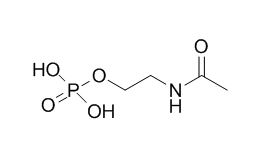2-Acetamidoethyl phosphate
Reference standards.
Inquire / Order:
manager@chemfaces.com
Technical Inquiries:
service@chemfaces.com
Tel:
+86-27-84237783
Fax:
+86-27-84254680
Address:
1 Building, No. 83, CheCheng Rd., Wuhan Economic and Technological Development Zone, Wuhan, Hubei 430056, PRC
Providing storage is as stated on the product vial and the vial is kept tightly sealed, the product can be stored for up to
24 months(2-8C).
Wherever possible, you should prepare and use solutions on the same day. However, if you need to make up stock solutions in advance, we recommend that you store the solution as aliquots in tightly sealed vials at -20C. Generally, these will be useable for up to two weeks. Before use, and prior to opening the vial we recommend that you allow your product to equilibrate to room temperature for at least 1 hour.
Need more advice on solubility, usage and handling? Please email to: service@chemfaces.com
The packaging of the product may have turned upside down during transportation, resulting in the natural compounds adhering to the neck or cap of the vial. take the vial out of its packaging and gently shake to let the compounds fall to the bottom of the vial. for liquid products, centrifuge at 200-500 RPM to gather the liquid at the bottom of the vial. try to avoid loss or contamination during handling.
Front Pharmacol.2022, 13:906763.
Toxicol In Vitro.2023, 86:105521.
Sains Malaysiana2024, 53(2):397-408.
Front Pharmacol.2022, 13:972825.
Natural Product Communications2022, 7(3):1-7.
Phytomedicine.2018, 38:12-23
J Nat Prod.2018, 81(4):966-975
Front Pharmacol.2020, 11:683.
Sci Rep.2023, 13(1):13072.
Front Mol Neurosci.2023, 15:1083189.
Related and Featured Products
Carbohydr Res. 2003 Oct 31;338(22):2387-92.
Structure of the O-polysaccharide of Proteus mirabilis O38 containing 2-acetamidoethyl phosphate and N-linked D-aspartic acid.[Pubmed:
14572723]
METHODS AND RESULTS:
The O-antigen of Proteus mirabilis O38 was found to be unique among bacterial polysaccharides and to have the following structure: [carbohydrate structure in text] where D-Qui4N(Ac-D-Asp) is 4-(N-acetyl-D-aspart-4-ylamino)-4,6-dideoxy-D-glucose and AcEtnP is 2-Acetamidoethyl phosphate. Neither of these entities have been hitherto found in natural polysaccharides.
Eur J Biochem. 1997 Jul 15;247(2):716-24.
Deletion of the heptosyltransferase genes rfaC and rfaF in Escherichia coli K-12 results in an Re-type lipopolysaccharide with a high degree of 2-aminoethanol phosphate substitution.[Pubmed:
9266718]
METHODS AND RESULTS:
The chromosomal genes rfaC and rfaF of Escherichia coli W3110 were inactivated by allelic-replacement mutagenesis to generate a defined strain lacking both heptosyltransferases which catalyze in lipopolysaccharide (LPS) biosynthesis the transfer of the first two L-glycero-D-manno-heptose (Hep) residues to 3-deoxy-D-manno-2-octulosonic acid (Kdo). The LPS of the mutant was isolated and its chemical structure was investigated by compositional analysis and nuclear magnetic resonance spectroscopy of isolated, deacylated oligosaccharide phosphates. The basic structure was a tetrasaccharide alpha-Kdo-(2-->4)-alpha-Kdo-(2-->6)-beta-D-GlcN4P-(1-->6)-alpha-D- GlcN1P which in LPS was substituted at position 07 of Kdo II by 2-aminoethanol phosphate in non-stoichiometric amounts. 2-Aminoethanol was cleaved during deacylation of the LPS by successive hydrazinolysis and KOH treatment and, in addition, phosphate migration from 07 to 08 of Kdo II occurred. Thus, the oligosaccharides alpha-Kdo7P-(2-->4)-alpha-Kdo-(2-->6)-beta-D-GlcN4P-(1-->6)- alpha-D-GlcN1P and alpha-Kdo8P-(2-->4)-alpha-Kdo-(2-->6)-beta-D-GlcN4P-(1-->6)- alpha-D-GlcN1P could be isolated. KOH treatment of the two trisphosphates and authentic methyl 3-deoxy-D-manno-octulopyranoside 7-(2-Acetamidoethyl phosphate) proved that phosphate migration only took place when the phosphate group was substituted with 2-aminoethanol.
CONCLUSIONS:
Complementation studies with plasmid-encoded rfaC and rfaF genes revealed that the mutant strain can be used in combination with LPS-specific antibodies for the cloning and characterization of heptosytransferases which glycosylate Kdo residues of the inner core region of LPS.



